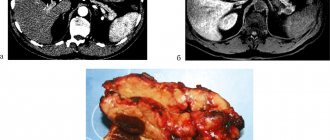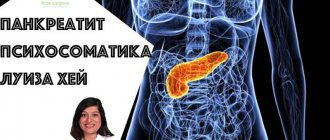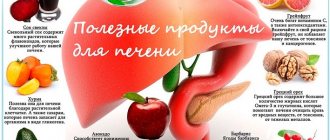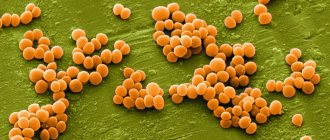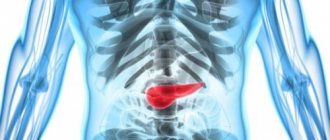Acute and chronic diseases of the pancreas negatively affect the state of the digestive system. Thus, with chronic pancreatitis, the digestibility of certain foods is often impaired, fermentation processes in the intestines are enhanced, and flatulence occurs.
In this case, a therapeutic diet is an important method of treatment. To plan dietary meals, patients often try to find information about what foods the pancreas likes. Based on the patient's condition, a nutritionist can recommend several basic nutritional options.
Anatomy and functions of the pancreas
Nutrition plays a huge role in the treatment of pancreas
The human pancreas is the most important mixed secretion gland. This organ releases hormones into the blood and synthesizes digestive enzymes, which are necessary for the absorption of proteins, carbohydrates and fats.
The pancreas is located in the abdominal cavity next to the stomach and small intestine. This organ is functionally connected to the duodenum, where enzymes are released during digestion.
Main functions of the organ:
- Breakdown of complex protein, lipid and carbohydrate substrates into simple components.
- Release of glucagon and insulin into the blood. These hormonal substances affect the metabolism of carbohydrates in the body.
- Damage to areas of the organ that synthesize insulin is one of the causes of diabetes mellitus.
The pancreas is often exposed to various pathological factors. This may be inflammation of the glandular tissue as a result of blockage of the excretory ducts, infection and the growth of malignant cells. In this case, diseases of the organ affect both digestive and metabolic functions.
Exacerbation of pancreatitis: nutrition rules
In the first days of the disease, when the pain syndrome is pronounced, it is necessary to adhere to the principle: “hunger, cold and rest.” That is, all foods are excluded, a heating pad with ice is placed on the stomach, the patient must maintain physical and emotional rest.
In the first or second days from the onset of an exacerbation, fasting is indicated. You should only drink 1-1.5 liters of liquid (a glass 5-6 times a day).
Recommended:
- alkaline mineral waters (sodium bicarbonate) without gas. The most popular of them are Narzan and Borjomi.
- Rosehip decoction (no more than 400 ml per day)
- weak tea.
From 3-4 days, mucous decoctions and liquid, boiled porridge are introduced into the menu. On days 5-6, a protein omelet, pureed buckwheat or oatmeal, some crackers, boiled vegetables, and meals up to 6 times a day in small portions are allowed. Puddings, mousses, casseroles, and diluted juices are gradually being introduced into the menu. As the acute period subsides, they switch to the main diet.
The daily amount of necessary nutritional elements of the dietary table during exacerbation of pancreatitis:
- whites: 85-90 gr. (half of them are of animal origin);
- fats: 70-80 gr. (of which a third are plant-based);
- carbohydrates: 300-350 gr.
- table salt 6-8 gr. (food should be under-salted);
- free liquid 1.5-2 liters.
The energy value of the diet is 2170 - 2480 kcal.
Reasons for the development of pancreatitis
Pancreatitis can develop due to the influence of various pathological factors. Usually lies
Fast food is strictly prohibited!
Some people associate the appearance of this disease with an improper diet, the general health of the patient, previous injuries and chronic diseases of the abdominal organs.
Risk factors:
- Alcoholism and smoking.
- Frequent consumption of fatty, salty or spicy foods.
- Cholelithiasis.
- Consequences of surgical intervention in the abdominal cavity.
- High concentration of calcium in the blood.
- Excessive hormonal activity of the thyroid gland.
- Excess triglycerides in the body.
- Infectious diseases of the pancreas.
- Abdominal trauma.
- Cystic fibrosis.
- Taking certain medications.
- Pancreas cancer.
- Genetic factors.
Doctors are not always able to identify the root cause of pancreatitis in a patient.
Products allowed and prohibited
Products that are recommended to be eaten during pancreatitis should facilitate the work of the pancreas as much as possible, reduce the amount of enzymes it synthesizes, quickly evacuate from the stomach and small intestine, and not cause flatulence, which provokes already existing abdominal pain.
In addition, to facilitate the synthesis of enzymes in the pancreas, which contain proteins, food should be easily digestible and rich in proteins.
If you have pancreatitis, you should avoid foods that stimulate the production of gastric juice and, accordingly, pancreatic secretions. That is, the production of pancreatic enzymes significantly exceeds the required need for them for the digestive tract as a whole, and therefore, with pancreatitis, the excess enzymes are spent on digesting the own pancreas. To reduce the amount of synthesized enzymes and relieve inflammation of the organ, it is necessary to give up a number of foods.
| Prohibited foods for pancreatitis | Authorized Products | |
| Soups | in meat, mushroom and fish broths, complex (cabbage soup, borscht, rassolnik), dairy, cold (okroshka, beetroot soup). | Soups should be vegetarian, with pureed vegetables (carrots, pumpkin, zucchini, potatoes), with noodles, semolina or oatmeal. |
| Bread | Fresh wheat or rye, puff pastry and pastry products, flatbreads, fried pies. | Day-old or dried white bread, dry unsweetened cookies, crackers. |
| Meat | Fatty meats (pork, lamb) and poultry (duck, goose), sausages, liver, kidneys and brains, smoked meats and canned food. | Low-fat varieties (beef without films and tendons, veal), white meat chicken, turkey, rabbit. The meat should be boiled and preferably pureed (soufflé, steamed cutlets, dumplings), beef stroganoff. |
| Fish | Fatty fish, salted and smoked, fried, canned. | Low-fat varieties (cod, pollock) boiled or chopped, aspic. |
| Dairy | Among lactic acid products, you should avoid those that have a high percentage of fat content - sour cream, fatty, salty and spicy types of cheese. | Low-fat milk, non-sour and low-fat cottage cheese, yoghurts, kefir, curdled milk no more than 2% fat, unsalted and low-fat cheeses. |
| Cereals | A ban on pearl barley, millet, corn and wheat cereals, as they remain in the stomach and intestines for a long time, stimulating the production of pancreatic juice. | Buckwheat (mashed), oatmeal, semolina, rice porridge in water with milk 50/50, puddings and casseroles with cereals, cottage cheese. |
| Eggs | Fried and hard-boiled. | Omelettes steamed from whites, it is allowed to add 1 yolk no more than once a week |
| Vegetables | Cabbage, eggplant, radish, turnip, radish, garlic and spinach, bell pepper. | Potatoes, carrots, zucchini, beets, cauliflower, pumpkin, green peas. |
| Dessert | Chocolate, raw unprocessed fruits and berries (dates, grapes, figs, bananas), ice cream, jam. | It is better to replace sugar with xylitol, use only ripe and non-acidic varieties of fruits and berries, prepare mousses, jellies, puddings, compotes (all pureed), baked apples from them. |
| Spices and sauces | Black and red pepper, coriander, horseradish, hot tomato sauce, vinegar | Dairy or sauces based on diluted vegetable broth; do not sauté when adding flour. |
| Fats | All refractory fats (pork, beef, lamb fat), tail fat. | Butter (no more than 30 grams per day), refined vegetable oil (10 - 15 grams), add oils to ready-made dishes without heating them. |
| Beverages | Coffee, cocoa, strong tea, sweet carbonated drinks, grape juice. | Lightly brewed tea with lemon, still mineral water, rosehip infusion, juices half diluted with water. |
The role of diet in treatment
The pancreas does not like smoked meats
Once a diagnosis is made, treatment and diet should be the first priority.
The need to change your diet is due to the importance of preventing nutritional deficiencies in the body, normalizing blood sugar levels and facilitating the functioning of the pancreas.
The diet for pancreatitis must be designed in such a way that the patient receives all the necessary nutrients during the day. In this case, an important task is to facilitate digestive function, so it is necessary to select easily digestible foods.
Even with the use of artificial pancreatic enzymes, a significant proportion of food substrates is not digested and is excreted in the stool.
Basic recommendations:
- It is necessary to eat small portions 6-8 times a day. This diet significantly reduces the load on the digestive tract and improves the absorption of nutrients.
- The proportion of fatty foods in the diet should be reduced. It is recommended to pay attention to plant sources of polyunsaturated fatty acids as compensation.
- It is also important to reduce the amount of fiber in your diet. This complex carbohydrate significantly slows down the digestive process and increases the load on the pancreas.
- To prevent deficiency of minerals and vitamins, you can take multivitamin complexes.
- The need to take supplements is due to the inability of the digestive organs to absorb all the necessary nutrients.
A proper diet is an important addition to drug treatment for acute and chronic pancreatitis. It is important to consider what foods the pancreas likes and what foods need to be excluded from the diet.
How to build a diet for pancreatitis
An approximate menu for pancreatitis usually includes 3 main meals (breakfast, lunch, dinner), 2 snacks between them and a fermented milk drink shortly before bedtime.
For breakfast
It is preferable to cook viscous porridges in water; during the period of stable improvement, I use diluted milk for cooking. First, they are ground or served in the form of a soufflé, and then boiled well enough. Breakfast is complemented by a sandwich made from day-old dried bread with a small amount of butter (no more than 10 grams per day). You can eat a piece of low-fat cheese or low-fat ham.
Second breakfast (snack)
may consist of cottage cheese or meat soufflé, baked apple with cottage cheese or honey, sweetened cottage cheese, steamed or baked omelet. Compote or rosehip infusion is also served.
Dinner
consists of various soups, a main course and a drink. Soups are cooked in a second broth and sometimes seasoned with a small amount of sour cream. The second course necessarily includes a protein dish, which can be supplemented with a vegetable or cereal side dish.
For afternoon tea
The choice of dishes is about the same as for the first snack. It can also consist of jelly and biscuits, sometimes banana.
Dinner
should be easy enough to digest, but with enough protein and carbohydrates. These can be soufflés, casseroles, meat and curd quenelles, meat rolls in an omelet, boiled meat/fish, and a side dish is added to them.
For the night
– kefir or other permitted low-fat fermented milk products.
Following a diet for pancreatitis can quickly improve and stabilize the condition for a long time. After all, the therapeutic diet on the 5p table is balanced, provides the body with all the necessary nutrients, spares the affected pancreas as much as possible and helps normalize its function.
In the absence of errors in nutrition, pancreatitis remains compensated for a long time and is not accompanied by uncomfortable symptoms, and the additional use of enzyme preparations allows one to avoid insufficient digestion of food.
Important: before use, read the instructions or consult your doctor.
Diet features
What foods does the pancreas love?
If you have pancreatitis, you need to add more whole grains, fruits, vegetables and low-fat dairy products to your diet.
At the same time, you need to avoid eating fatty, fried, spicy foods and alcohol. It is also necessary to regularly monitor the condition of the digestive organs using various diagnostic methods.
Recommended Products:
- Fruits and berries: blueberries, cherries, grapes, plums, mangoes, apples, bananas and prunes.
- Vegetables: beets, broccoli, spinach, potatoes, cucumbers and carrots.
- Rice, buckwheat and lentils.
- Almonds, walnuts, pistachios and pumpkin seeds.
- Kefir, yogurt and yogurt.
- Eggs, beef and chicken.
- Products to avoid:
- Fatty types of red meat.
- Fried and spicy foods.
- Alcoholic drinks.
- Semi-finished meat products.
- Chips, crackers and other snacks.
- Mayonnaise.
- Margarine and vegetable oil.
- Fatty dairy products.
- Baked goods and foods with excess sugar.
Heavier foods, such as chicken, lentils and vegetables, are best for lunch. In the morning you need to eat porridge and fruit. The last meal should be no later than 6-8 pm.
Menu for the week
When creating a menu, it is advisable to diversify the daily set of products as much as possible so that a patient with pancreatitis does not experience a lack of individual nutrients. To do this, it is advisable to use products from different groups daily, prepare them in different ways and combine them in different ways. See below for an example of such a menu for the week.
Menu for Monday
Breakfast - liquid semolina porridge with milk diluted with water, weakly brewed tea.
Second breakfast - mashed cottage cheese, a slice of dried bread with a spoonful of fruit jelly, rosehip infusion.
Lunch - creamy pumpkin soup with cream, minced sirloin cutlet, tea.
Afternoon snack - protein omelet with a spoonful of sour cream, compote.
Dinner - carrot puree with cream, meatballs, tea with milk.
Before bed - a glass of acidophilus.
Menu for Tuesday
Breakfast - pureed rice porridge with butter, tea.
Second breakfast - jelly, biscuits.
Lunch - soup with pureed vegetables, meatballs with pureed buckwheat porridge, compote.
Afternoon snack - fruit soufflé, rosehip infusion.
Dinner - fish cutlet, mashed potatoes, tea.
Before going to bed - pureed cottage cheese.
Menu for Wednesday
Breakfast - oatmeal porridge with milk, compote.
Second breakfast - soft-boiled egg, pumpkin juice.
Lunch - cream soup of vegetables, meat soufflé, jelly.
Afternoon snack - cottage cheese casserole, rosehip infusion.
Dinner - minced meat roll with vegetables, tea with milk.
Before bed - yogurt.
Menu for Thursday
Breakfast - boiled egg, dried bread with a spoonful of jam, tea
Second breakfast - baked apple, dried fruit compote.
Lunch - soup with vegetables, baked vegetables, a piece of boiled rabbit fillet, tea with milk.
Afternoon snack - fruit and berry jelly, tea.
Dinner - boiled fish, puree of any vegetables, compote.
Before bed - kefir.
Menu for Friday
Breakfast - oatmeal porridge with water, meat soufflé, tea with milk.
Second breakfast - rice pudding, carrot juice.
Lunch - vegetable soup, minced fish roll with stewed vegetables, tea.
Afternoon snack - white omelette, compote.
Dinner - zucchini casserole, quenelles, tea.
Before going to bed - rosehip infusion, marmalade.
Menu for Saturday
Breakfast - omelet with milk, toast with a piece of mild cheese, tea.
Second breakfast - pumpkin puree, compote.
Lunch - soup with rice and vegetables, steamed cutlets with rolled oats porridge, tea with milk.
Afternoon snack - fruit mousse, biscuits, rosehip infusion.
Dinner - buckwheat porridge, meatballs, fruit juice diluted with water.
Before bed - cottage cheese with a spoonful of jam.
Forms of pathology
There are several forms of pancreatic inflammation. People of any age can suffer from them: children, adults and the elderly.
- Acute pancreatitis. Develops over several hours, usually after eating a large amount of food. Patients experience severe nausea with vomiting, pain in the upper abdomen, accompanied by diarrhea, bloating and belching. Severe fever is likely: heavy sweating, high body temperature, weakness. During the destructive process, abscesses and foci of necrosis arise, requiring immediate surgical intervention.
- Reactive interstitial pancreatitis is a type of acute form of inflammation, more typical for childhood. It is manifested by high anxiety temperature with sharp abdominal pain, accompanied by swelling of the gland and the release of the enzyme trypsin, which destroys its tissue. This process is reversible, unlike necrotizing, but also requires urgent medical intervention.
- Chronic pancreatitis. It may not make itself felt for decades, and the period of remission is asymptomatic. During exacerbations, it is manifested by severe dyspepsia, abdominal pain, loss of appetite, general intoxication, and fever. Often accompanied by chronic cholecystitis or gastritis, it requires regular maintenance therapy and lifestyle adjustments.
Pancreatitis causes disturbances in the functioning of the liver, gastrointestinal tract, vascular system, and kidneys. In most cases, the inflammatory process does not affect the endocrine functions of the gland and is not associated with the development of diabetes mellitus.
List of fully or partially restricted products:
| Dates, grapes, bananas | Causes bloating |
| Mushrooms, legumes, white cabbage | Contains coarse fiber |
| Smoked, salted, fast food, products containing preservatives and dyes | Irritate the mucous membrane of the digestive tract |
| By-products (liver, tongue, heart, kidneys, etc.) | Contains a lot of cholesterol |
| Any fried or fatty foods | Lead to exacerbation of the disease |
| High fat dairy products | High risk of exacerbation or complication of the disease |
